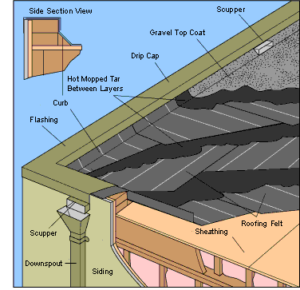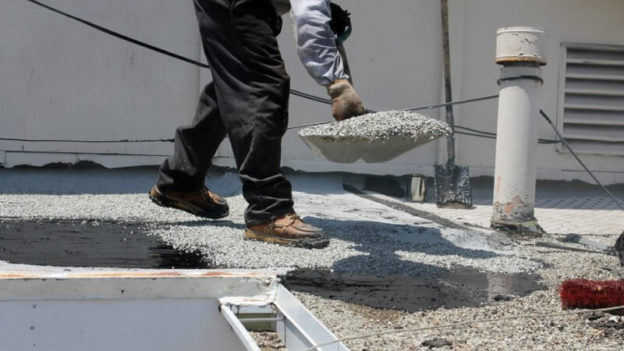Roofers have been using tar and gravel to cover roofs for a long time now, and for good reason. It’s still a viable option for you and your roof, and in this article – we’re going to look at why.
Tar and gravel roofing presents a number of benefits for mainly flat roofs. While it can be used on slightly pitched roofs, it’s mostly a solution for flat commercial ones.
However, since it’s so cheap and easy to apply, it also has uses in other types of construction.
As architectural tastes change, more and more residential homes are starting to use finishes that have often been reserved only for commercial buildings.
So whether you’re interested in tar and gravel for your commercial, residential, or other type of building – you’re in the right place.
In this article, we’re going to look at some of the pros and cons of tar and gravel roofing, as well as what to look for when choosing the right contractor to carry out the job.
What is tar and gravel roofing?
 The reality of “tar and gravel” roofing is that the actual material is slightly more sophisticated than it first sounds.
The reality of “tar and gravel” roofing is that the actual material is slightly more sophisticated than it first sounds.
The material used for this sort of roof finish is made from fibre-glass asphalt sheeting and is applied in layers to the vast majority of homes and commercial buildings with flat or nearly flat roofs.
It’s actually one of the most common roofing materials used in the industry.
Between each layers or sheeting hot bitumen is applied to form a seal. The top layer is then coated with more bitumen and a layer of stone, rock or gravel to hold the other materials down.
This also acts as a way of protecting the roof from weather abrasion and other external effects.
How long can tar and gravel roofs last?
There’s a bit of variance when it comes to asking exactly how long a tar and gravel roof might last. It’s not the most long-lasting of roof solutions, but it’s a cheap and effective way to protect your building in the short term.
This makes it especially popular for property developers or people who’re trying to sell a home or building and are less concerned about how long their roof is going to last.
Roofs built up with layers of tar and gravel normally last between 10 and 20 years. This can often depend on the sort of external weather conditions they’re under pressure from.
So if you live somewhere with extreme heat, wind or other weather factors, your tar and gravel roof might not last quite as long.
There’s another type of roofing that’s slightly similar to tar and gravel called asphalt roll roofing. This has the same general materials but only has one thin layer that’s rolled out onto roofs – often on garages or other secondary buildings rather than main residences.
This is very cheap and easy to install, but also doesn’t last as long – sometimes only 5 to 10 years.
But it’s still a viable option if you’re looking to get something roofed quickly, easily, and cheaply.
What are the advantages of tar and gravel roofing?
1. If you’ve got a flat roof that you need covering, tar and gravel is one of the most popular options for good reason. First and foremost – it’s the cheapest.
2. While you might be slightly put off by the shorter life-spans of these simple roof finishes, you can’t argue with how cheap they are.
3. Tar and gravel roofs are also quick and easy to install, and can be administered by most good roofing companies.
4. There are other roofing solutions that need highly trained specialists to apply, and while this is often more expensive, it can also make it harder to find the right roofer in some locations.
That isn’t a problem with tar and gravel, as it’s one of the most well-known solutions in the industry.
5. Tar and gravel also provides good UV protection and is an excellent fire-resistant material. It’s also considered by some to be quite an aesthetic finish for certain types of buildings.
6. One other benefit of a tar and gravel roof is how solid it is and easy to walk on. That simply isn’t the case with every type of roof, so if you need to do a lot of maintenance to your building, or have a design that needs to be walked on occasionally (like in order to clean windows) then it could be a very good choice.
7. While tar and gravel roofs might not last quite as long as some other roofing solutions, they are easy and cheap to maintain. If looked after properly, the duration of the roof could be extended considerably.
What are some disadvantages of tar and gravel roofs?
While tar and gravel does have a number of benefits for your roof, it also has some drawbacks. Let’s have a look at some of the biggest ones:
1. Tar and gravel roofs can be very heavy. One of the benefits of a flat roof is often its lightweight design, but this benefit can be lost with a tar and gravel roof.
For some buildings, you might need to strengthen the structure before you have the layers applied, so it’s important that you check with a qualified professional before you get the job done.
If structural work is required prior to application, this could negate the cost benefit of getting a tar and gravel roof in the first place.
2. Tar and gravel can also be messy and smelly to apply, which makes it difficult to put on homes while someone is living in them.
3. Tar and gravel can also be dangerous, so it’s important you only rely on a good roofing firm and don’t attempt to do it yourself.
4. It can also be difficult to find leaks in a tar and gravel roof, and the duration might not be as long as some other finishes. When looking for a company to carry out your tar and gravel roof, it’s important you pick someone who’s got plenty of references and finished roofs they can show you.
Hopefully, you’ve now seen enough of the pros and cons associated with tar gravel roofing to make an informed decision about your own roof.












